

Adapting A Social Learning Strategy Framework For Education. Clip: 'Where Do We Invade Next?' - Collective Evolution. The Research Behind Social and Emotional Learning. Teaching without implementing social and emotional learning (SEL) is like leading kids without shoes on a trek across the Appalachians.
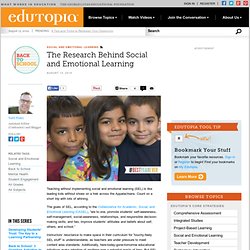
Count on a short trip with lots of whining. The goals of SEL, according to the Collaborative for Academic, Social, and Emotional Learning (CASEL), “are to one, promote students’ self-awareness, self-management, social-awareness, relationships, and responsible decision-making skills; and two, improve students’ attitudes and beliefs about self, others, and school.” Instructors’ reluctance to make space in their curriculum for “touchy-feely SEL stuff” is understandable, as teachers are under pressure to meet content area standards. Additionally, here-today-gone-tomorrow educational initiatives make adoption of anything new a potential waste of time.
But SEL is different. The Data Speaks One advantage of SEL is that it serves the most vulnerable K-12 kids -- a number that is growing. Avoiding Common Mistakes When Implementing SEL. How More Social and Emotional Learning (and Less Academics) Actually Builds Academic Success. With all of the high-stakes testing in our schools, and the resulting judgments and consequences for students and teachers, it is no wonder that schools are taking time away from activities like recess, breaks, art, music... to spend more time on academics.
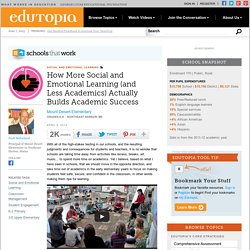
Yet I believe, based on what I have seen in schools, that we should move in the opposite direction, and take time out of academics in the early elementary years to focus on making students feel safe, secure, and confident in the classroom, in other words making them ripe for learning. Morning Meetings. Replacing Teachers with Emotion. Image credit: iStockphoto Teachers mean well.
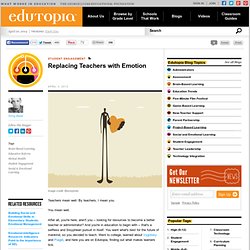
By teachers, I mean you. You mean well. After all, you're here, aren't you -- looking for resources to become a better teacher or administrator? What is social learning? Part One: the personal experience. In this series of three articles, i want to explore social learning from the perspective of the individual and the organisation in today’s workplace and then take a look to the future, to where social may take us.
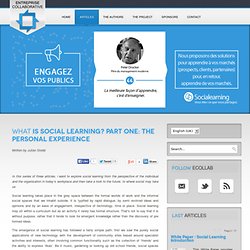
Social learning takes place in the grey space between the formal worlds of work and the informal social spaces that we inhabit outside. It is typified by rapid dialogue, by semi evolved ideas and opinions and by an ease of engagement, irrespective of technology, time or place. Social learning may sit within a curriculum but as an activity it rarely has formal structure. That’s not to say that it is without purpose, rather that it tends to look for emergent knowledge rather than the discovery of pre formed ideas.
At the heart of social learning is a new dynamic, that the proletariat are in charge of the messaging. Defining Social Learning. Defining Social Learning Two years after we published The New Social Learning, I still hear people say “there is no definition” or worse yet, defining it in truly silly ways.
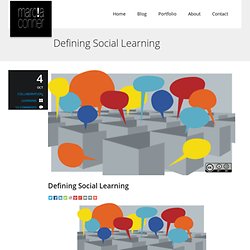
A post with a slide of my definition is consistently one of the most popular posts on this site so I thought people might appreciate more on how I define the terms and what social learning is not. I’ll frame this in the questions I’m often asked. Teaching Students the ABCs of Resilience. From natural disasters to economic meltdowns, from wars abroad to tragic shootings close to home, this year brought to light the increasing complexity of the world in which we raise kids.

Our natural instinct as teachers, parents and caretakers is to protect children from hardship, yet we know walking between the raindrops of adversity is not possible. Instead of sidestepping challenge, we can teach kids to cope positively, to learn and grow from adversity. We can arm our youth with skills of resilience, and these lessons can begin in the classroom. Understanding the Roots of Resilience Have you ever wondered why one student may be more resilient than another? Building Social and Emotional Skills in Elementary Students: The Power of Appreciation. In this nine-part series, we will look at important factors that influence the happiness and social and emotional learning of elementary school age children.

These factors are very useful in helping students learn, manage emotions and increase empathy. Each blog features one letter of the acronym HAPPINESS: H = Happiness A = Appreciation P = Passions and Strengths P = Perspective I = Inner Meanie, Inner Friend N = Ninja Mastery E = Empathy S = So Similar S = Share Your Gifts In this article, we’ll explore appreciation, which is a pillar of happiness and one of the fastest ways to shift a student's mood and perspective. The definition of appreciation is "gratitude; thankful recognition. " Accentuate the Positive Cultivating gratitude, which leads to positivity, is important in that it has a direct relationship to learning. Social-Emotional Needs Entwined with Students' Learning, Security. Poster: 21stC Mobile Social Learning. Here’s my summary of how I aim to teach but appreciate this will change rapidly over the years.
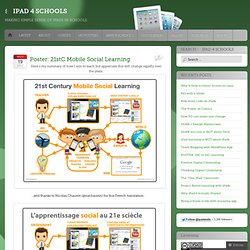
…and thanks to Nicolas Chauvin (@nxchauvin) for this French translation: Like this: Like Loading... Defusing Power Struggles: It's Not About Getting the Last Word. Mrs.

Nelson is teaching a lesson when she notices Mason's head on his desk with distracting noises coming from him. She cruises his way while still teaching, leans in as she nears him and quietly reminds him to sit up and stop making noises. As she walks away and resumes teaching, Mason mumbles an inappropriate epithet that contains denial of the deed and offensive language. Other students sitting nearby turn their attention away from the lesson, collectively showing a look along with a few "oohs" that unmistakably challenges their teacher with the question, "What are you going to do about it? " Mrs. Many power struggles start over issues of consequences, fairness, embarrassment and being told what to do. The Most Effective Word. Social Learning and Knowledge Management.
The Nonaka and Takeuchi Knowledge Spiral (click on the image to learn more) For about five years around the turn of the century most of my days were spent helping clients manage their knowledge.

Back in 2000 knowledge management (KM) was really big. Every year I’d head off to Amsterdam for the obligatory industry conference, KM Europe. We even had our own home grown conference, KM UK, with pretty much the same people but with less impressive venues. Then suddenly things went quiet – KM Europe was suddenly cancelled in 2005, KM UK limped along (and is still going today). KM still goes on but it’s likely to be on the margins and not essential for peak organisational performance whereas in 2000 KM really was positioned as a game changer.
So what happened? The KM wave was initially driven by big tech – the idea that an organisation could somehow manage its knowledge was attractive in an economy where knowledge was as important as capital. Social Emotional Learning. Social & Emotional Issues - Teacher Resources. Highlights Earth Day Kids love hearing about the Earth and ways we can be better to our environment! We've gathered some great resources to help you celebrate Earth Day (April 22) with your class. Sample SEL Activities. Building Social and Emotional Skills in Elementary Students: Passion and Strengths. In this nine-part series, we will look at important factors that influence the happiness and social and emotional learning of elementary school age children. These are very useful in helping students learn, manage emotions better and increase empathy.
Each blog features one letter of the acronym HAPPINESS: CSEFEL: Center on the Social and Emotional Foundations for Early Learning. Illinois Learning Standards for Social/Emotional Learning(SEL) Social and Emotional Learning: What is it? How can we use it to help our children? Introduction. Collaborative for Academic, Social, and Emotional Learning. Resources and Downloads from WINGS for Kids. Activities to Build Social and Emotional Skills in Elementary Students.
Happiness is something we all want, and new research shows that happiness and well-being can be taught! But who has time to teach happiness when there is so much else to cram into a school day? At the university level, we see courses at Harvard and University of Southern California on the Science of Happiness. There are good reasons why those courses are among these schools' most popular classes. Happier people tend to be healthier, more productive, more generous and kinder to others. They also learn more easily and enjoy life.
How Parents and Schools Can Help Build Kids’ Emotional Strength. Culture By Matt Levinson. Social and Emotional Learning.